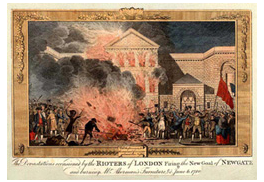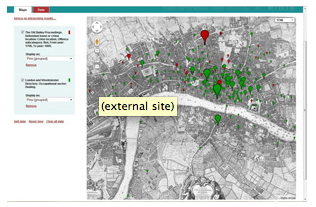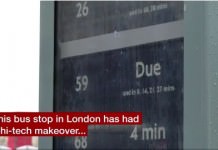
From the press release:
Interactive maps reveal London’s history in unprecedented detail : JISC: “Locating London’s Past is a new JISC-funded website that lets users delve deep into the capital’s past, revolutionising our understanding of London’s history. The website is the first to map information from a vast array of sources, covering:
crime and punishment the distribution of wealth, poverty and occupations the ownership of consumer goods mortality Alastair Dunning, programme manager at JISC, said: “Researchers in the humanities and social sciences are turning increasingly to geographical analysis as a way of bringing the facts and figures to life. What’s exciting about this resource is that the existing data you can explore today is just the start – the interface could be expanded to include new data sets and new maps, making it potentially useful to scholars in dozens of different disciplines. JISC’s commitment to funding open source projects means that other universities are already looking at how they might reuse the programmes that the Sheffield team has developed.”
Trial accounts from the Old Bailey, tax and population data, and even archaeological records can all be uploaded onto John Rocque’s famous 1746 map of London, now fully referenced to modern geographical coordinates by Museum of London Archaeology (MOLA).
Locating London’s Past is the result of a collaborative project between the University of Sheffield, the University of Hertfordshire, and the University of London.
Using the new website, people are now able to explore fully geo-referenced detail using Google maps technology to reveal the distribution of crimes, wealth and poverty, mortality, archaeological finds, voting records and much more.
Professor Tim Hitchcock from the University of Hertfordshire commented: “This project has allowed us to add a new, third dimension to our understanding of the first ‘World City’. Text on the page can now be reconfigured around place and space to create a new historical landscape to reveal pockets of crime and poverty, wealth, and illness. It allows us to know the past in a new way.”
18th Century riot trials
The interface for the website was developed by the University of Sheffield’s Humanities Research Institute (HRI), publishers of the prize-winning Old Bailey Online website. Professor Robert Shoemaker from the University of Sheffield’s Department of History commented: “Locating London’s Past makes it possible for the first time to map a wide variety of data from London’s past onto fully geo-referenced historical maps of the metropolis. For me, the most exciting findings concern the spread of crime locations from Old Bailey trials. Rather than simply reflecting the distribution of poverty (or wealth), criminal prosecutions took place in mixed areas, where social tensions were highest. These and other discoveries will transform our understanding of the historical development of Europe’s first modern city.”
Dr Matthew Davies, Director of the Centre for Metropolitan History at the University of London’s Institute of Historical Research, School of Advanced Study, commented: “The project’s website provides a new tool for understanding the relationships between the people and places of pre-modern London. It will enable the visualisation through maps of important characteristics of the metropolis during a time of rapid growth, from everyday patterns of family, home and work, to the interactions between inhabitants and institutions such as the parishes, hospitals and city companies.”
“

































